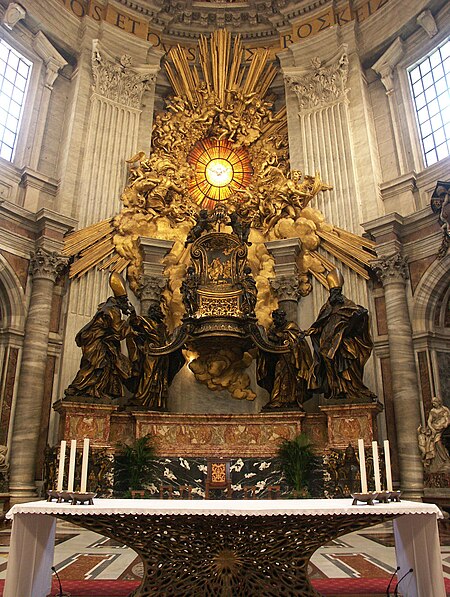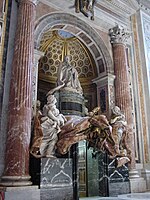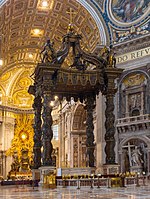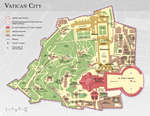Chair of Saint Peter

The Chair of Saint Peter (Latin: Cathedra Petri), also known as the Throne of Saint Peter, is a relic conserved in St. Peter's Basilica in Vatican City, the sovereign enclave of the Pope inside Rome, Italy. The relic is a wooden throne that tradition claims belonged to the Apostle Saint Peter, the leader of the Early Christians in Rome and first Pope, and which he used as Bishop of Rome. The relic is enclosed in a sculpted gilt bronze casing designed by Gian Lorenzo Bernini and constructed between 1647 and 1653. In 2012, Pope Benedict XVI described the chair as "a symbol of the special mission of Peter and his Successors to tend Christ's flock, keeping it united in faith and in charity."The wooden throne was a gift from Emperor of the Romans Charles the Bald to Pope John VIII in 875. It has been studied many times over the years, most recently between 1968 and 1974, when it was last removed from the Bernini altar. The study concluded that it was not a double, but a single chair, with a covering, and that no part of the chair dated earlier than the sixth century. The Chair of Saint Peter is the second altar within the church with the first one being the one under the baldacchino. It stands to remind visitors of the Catholic Church's authority.
Excerpt from the Wikipedia article Chair of Saint Peter (License: CC BY-SA 3.0, Authors, Images).Chair of Saint Peter
Sakristeistraße,
Geographical coordinates (GPS) Address Phone number Website Nearby Places Show on map
Geographical coordinates (GPS)
| Latitude | Longitude |
|---|---|
| N 41.902222222222 ° | E 12.453333333333 ° |
Address
Basilica di San Pietro (Basilica di San Pietro in Vaticano)
Sakristeistraße
00120 , Vatican City
Vatican City
Open on Google Maps








